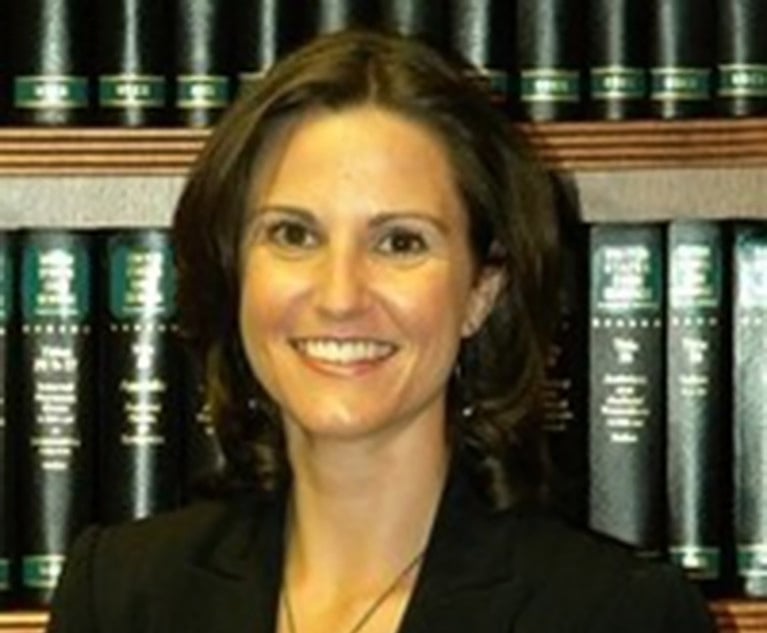The Time Has Come to End Mass Incarceration
Paul T. Shoemaker, Chair of the NYSBA General Practice Section, writes: Mass incarceration takes too large a toll on the individual, community and national levels. It is time to roll back mass incarceration and to bring America closer to fulfilling Dr. King's dream.
January 11, 2019 at 11:14 AM
6 minute read
 Paul T. Shoemaker
Paul T. Shoemaker
As we prepare to observe Martin Luther King Jr. Day, let us honor him by dedicating ourselves to eliminating the serious injustice of mass incarceration in America.
The statistics are grim. The United States has a prison population of 2.2 million, more than any other country. Our rate of incarceration is the highest in the world and falls with severe disproportionality on African Americans.
The rate of incarceration for black males in the 30- to 34-year-old age group is 6,412 per 100,000 individuals—a shocking rate of imprisonment of 1 out of every 16 men. Far too many are incarcerated for crimes that are not violent and far too many are incarcerated for possession of illegal drugs who are users. In addition, people convicted of non-violent crimes such as drug possession have been given sentences that are excessively long because the judge had no ability to make the punishment fit the crime and the defendant's circumstances as a result of mandatory statutory sentences.
The rate of imprisonment per 100,000 people is 148 in England, 62 in Japan and 30 in India, far below the overall incarceration rate of 737 in the United States. As our past President Sharon Stern Gerstman pointed out last year, the United States has 5 percent of the world's population, but 20 percent of the world's prison population, including a disproportionate number of people of color. President Gerstman established the Task Force on School to Prison Pipeline to study this issue.
Mass incarceration destroys the lives of prisoners and severely impacts families and communities, particularly minority communities.
The sheer cost of our prison system is staggering. Opposition to mass incarceration is coming both from those who wish to see people treated more fairly and from those who wish to see the government spend less. There is no reason for us to resort to draconian measures out of all proportion to those exercised in the rest of the world.
How did this happen? Scholars note that our prison sentences are far longer and that we have a harsh public attitude compared with other nations. We are virtually alone among industrialized nations in maintaining the death penalty and life sentences are much more common in the United States.
Moreover, just as the gun lobby is propped up by those who profit from the manufacture and sale of guns, the prison lobby is propped up by those who profit from the construction and use of prisons. In addition, prison expansion has been seen as a development strategy for depressed areas.
When, however, the huge costs of mass incarceration are considered, it is clear that something must be done. One solution is to release prisoners. Even conservatives have started to call for shorter and fewer prison sentences. People convicted of drug offenses (many involving a drug which now is being made legal) and other non-violent offenders should be treated with more leniency.
There also is hope to be found in the concept of restorative justice. Restorative justice is a program for dealing with people—especially young people—suspected of committing crimes that seeks to either divert them away from the criminal justice system or to prescribe a sentence of therapies and interventions instead of incarceration: a program supervised by the court designed to change a defendant's behavior for the better.
Restorative justice originated in New Zealand and has been used there with great success with the troubled indigenous Maori population. The New Zealand model typically involves family group conferencing. The meeting is attended by the alleged offender, his family, the victim, the police, a trained youth advocate, and other people the family wish to invite.
The youth advocate mediates between the family and the police. The offense is described and the young person admits or denies involvement. The victim describes the impact of the offense.
The participants then discuss how the matter might be resolved. The family deliberates privately and the meeting reconvenes with the professionals and the victim to see if they can agree on the plan advanced by the family. A typical plan may include a confession and apology by the offender, restitution, and participation in therapy, education and/or training.
Restorative justice and similar programs have started to gain traction here in the United States. For example, the U.S. District Court for the Southern District of New York has implemented the Young Adult Opportunity Program to help young defendants avoid incarceration. The program provides access to employment, counseling and treatment resources.
The Justice Court for the Village of Bronxville, N.Y. provides young offenders with the opportunity to avoid incarceration by participating in the Community Restorative Justice Program. This program is implemented through a Conditional Discharge, which allows the court to tailor a program of requirements for the defendant for a period of one year, which if performed to the court's satisfaction, will allow the defendant to be discharged without incarceration or probation. The program requires the individual to comply with specified therapies and interventions recommended by expert personnel who advise the court. The individual meets frequently with members of the community restorative justice staff of the Bronxville Justice Court. These and other steps are intended to assure that the offender complies with the law and achieves a degree of rehabilitation, usually aided by a year of psychological therapy, and understanding of the seriousness and long term consequences of his misconduct.
The value of a sentence of therapies and interventions or diversion from the criminal justice system can be substantial. Young people who are imprisoned are brutalized and exposed to career criminals. After leaving prison, they often perceive no opportunities for themselves other than lives of crime. These are the costs of mass incarceration on the individual level.
Mass incarceration takes too large a toll on the individual, community and national levels. It is time to roll back mass incarceration and to bring America closer to fulfilling Dr. King's dream.
Paul T. Shoemaker is a partner in Greenfield Stein & Senior.
This content has been archived. It is available through our partners, LexisNexis® and Bloomberg Law.
To view this content, please continue to their sites.
Not a Lexis Subscriber?
Subscribe Now
Not a Bloomberg Law Subscriber?
Subscribe Now
NOT FOR REPRINT
© 2025 ALM Global, LLC, All Rights Reserved. Request academic re-use from www.copyright.com. All other uses, submit a request to [email protected]. For more information visit Asset & Logo Licensing.
You Might Like
View All


Trending Stories
- 1Thursday Newspaper
- 2Public Notices/Calendars
- 3Judicial Ethics Opinion 24-117
- 4Rejuvenation of a Sharp Employer Non-Compete Tool: Delaware Supreme Court Reinvigorates the Employee Choice Doctrine
- 5Mastering Litigation in New York’s Commercial Division Part V, Leave It to the Experts: Expert Discovery in the New York Commercial Division
Who Got The Work
J. Brugh Lower of Gibbons has entered an appearance for industrial equipment supplier Devco Corporation in a pending trademark infringement lawsuit. The suit, accusing the defendant of selling knock-off Graco products, was filed Dec. 18 in New Jersey District Court by Rivkin Radler on behalf of Graco Inc. and Graco Minnesota. The case, assigned to U.S. District Judge Zahid N. Quraishi, is 3:24-cv-11294, Graco Inc. et al v. Devco Corporation.
Who Got The Work
Rebecca Maller-Stein and Kent A. Yalowitz of Arnold & Porter Kaye Scholer have entered their appearances for Hanaco Venture Capital and its executives, Lior Prosor and David Frankel, in a pending securities lawsuit. The action, filed on Dec. 24 in New York Southern District Court by Zell, Aron & Co. on behalf of Goldeneye Advisors, accuses the defendants of negligently and fraudulently managing the plaintiff's $1 million investment. The case, assigned to U.S. District Judge Vernon S. Broderick, is 1:24-cv-09918, Goldeneye Advisors, LLC v. Hanaco Venture Capital, Ltd. et al.
Who Got The Work
Attorneys from A&O Shearman has stepped in as defense counsel for Toronto-Dominion Bank and other defendants in a pending securities class action. The suit, filed Dec. 11 in New York Southern District Court by Bleichmar Fonti & Auld, accuses the defendants of concealing the bank's 'pervasive' deficiencies in regards to its compliance with the Bank Secrecy Act and the quality of its anti-money laundering controls. The case, assigned to U.S. District Judge Arun Subramanian, is 1:24-cv-09445, Gonzalez v. The Toronto-Dominion Bank et al.
Who Got The Work
Crown Castle International, a Pennsylvania company providing shared communications infrastructure, has turned to Luke D. Wolf of Gordon Rees Scully Mansukhani to fend off a pending breach-of-contract lawsuit. The court action, filed Nov. 25 in Michigan Eastern District Court by Hooper Hathaway PC on behalf of The Town Residences LLC, accuses Crown Castle of failing to transfer approximately $30,000 in utility payments from T-Mobile in breach of a roof-top lease and assignment agreement. The case, assigned to U.S. District Judge Susan K. Declercq, is 2:24-cv-13131, The Town Residences LLC v. T-Mobile US, Inc. et al.
Who Got The Work
Wilfred P. Coronato and Daniel M. Schwartz of McCarter & English have stepped in as defense counsel to Electrolux Home Products Inc. in a pending product liability lawsuit. The court action, filed Nov. 26 in New York Eastern District Court by Poulos Lopiccolo PC and Nagel Rice LLP on behalf of David Stern, alleges that the defendant's refrigerators’ drawers and shelving repeatedly break and fall apart within months after purchase. The case, assigned to U.S. District Judge Joan M. Azrack, is 2:24-cv-08204, Stern v. Electrolux Home Products, Inc.
Featured Firms
Law Offices of Gary Martin Hays & Associates, P.C.
(470) 294-1674
Law Offices of Mark E. Salomone
(857) 444-6468
Smith & Hassler
(713) 739-1250







